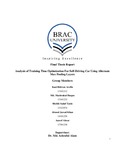Analysis of training time optimization for self-driving car using alternate max pooling layers
Abstract
In the modern era, the vehicles are focused to be automated to give human driver relaxed driving.
In the field of automobile various aspects have been considered which makes a vehicle automated.
As Udacity, in 2016, with the Google Self-Driving Car founder Sebastian Thrun open sourced their
self driving car simulation environment, a new door opened up in self driving vehicle research. In
this paper we have focused on comparing between a popular neural network model introduced by
NVIDIA and a model made with max pooling optimized neural network. Max pooling is a method
of making Convolutional Neural Network simpler. We have also worked vigorously on creating a
custom urban environment based on Dhaka, where we have run the car autonomously, gathered the
training time data, and the instances it fails to drive along the trained roadway. The idea described
in this paper is related to deep learning algorithm analysis and comparison, which is the core part
of the self driving car. The analysis hence gives us a great realization of machine learning
techniques and their effectiveness in practical situations. All being said, this paper, however
approaches to solve one big problem, to find out practicality of a popular model compared to an
unconventional model, put in a real scenario.

